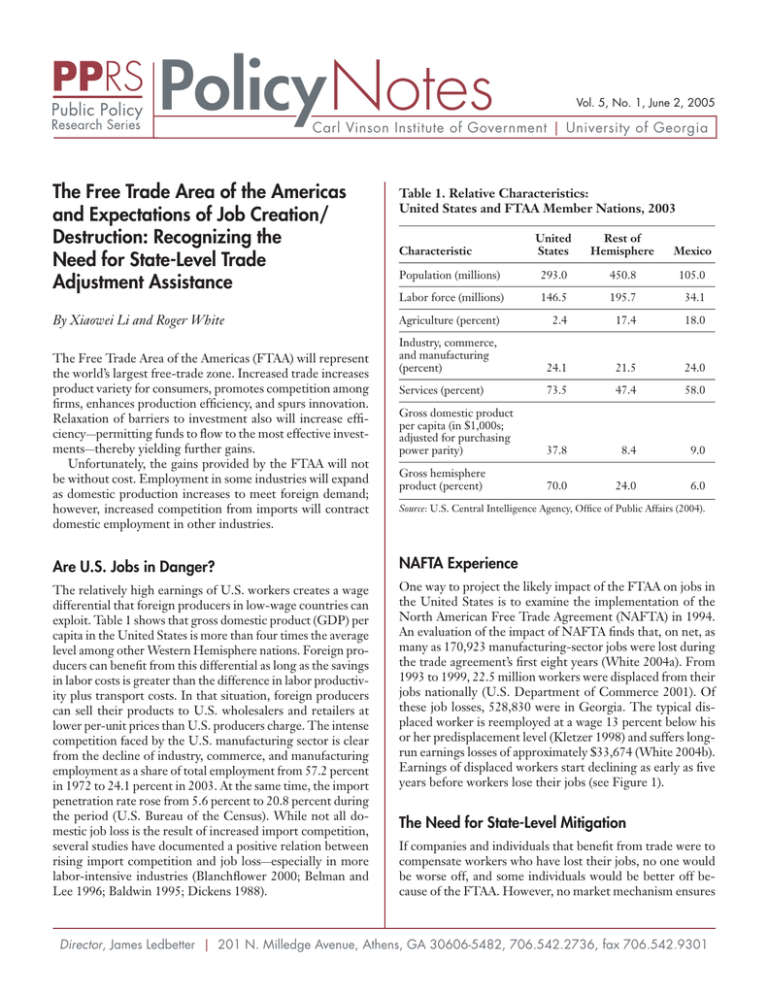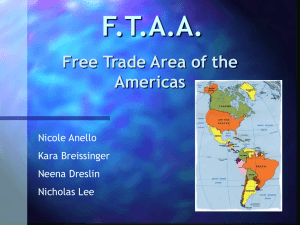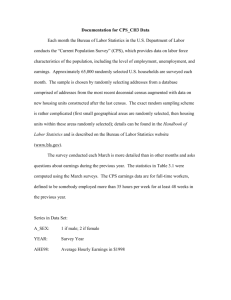Policy Notes
advertisement

Policy Notes Vol. 5, No. 1, June 2, 2005 Carl Vinson Institute of Government | University of Georgia The Free Trade Area of the Americas and Expectations of Job Creation/ Destruction: Recognizing the Need for State-Level Trade Adjustment Assistance By Xiaowei Li and Roger White The Free Trade Area of the Americas (FTAA) will represent the world’s largest free-trade zone. Increased trade increases product variety for consumers, promotes competition among firms, enhances production efficiency, and spurs innovation. Relaxation of barriers to investment also will increase efficiency permitting funds to flow to the most effective investciency— ments—thereby yielding further gains. Unfortunately, the gains provided by the FTAA will not be without cost. Employment in some industries will expand as domestic production increases to meet foreign demand; however, increased competition from imports will contract domestic employment in other industries. Table 1. Relative Characteristics: United States and FTAA Member Nations, 2003 United States Rest of Hemisphere Mexico Population (millions) 293.0 450.8 105.0 Labor force (millions) 146.5 195.7 34.1 Agriculture (percent) 2.4 17.4 18.0 Industry, commerce, and manufacturing (percent) 24.1 21.5 24.0 Services (percent) 73.5 47.4 58.0 Gross domestic product per capita (in $1,000s; adjusted for purchasing power parity) 37.8 8.4 9.0 Gross hemisphere product (percent) 70.0 24.0 6.0 Characteristic Source: U.S. Central Intelligence Agency, Office of Public Affairs (2004). Are U.S. Jobs in Danger? NAFTA Experience The relatively high earnings of U.S. workers creates a wage differential that foreign producers in low-wage countries can exploit. Table 1 shows that gross domestic product (GDP) per capita in the United States is more than four times the average level among other Western Hemisphere nations. Foreign producers can benefit from this differential as long as the savings in labor costs is greater than the difference in labor productivity plus transport costs. In that situation, foreign producers can sell their products to U.S. wholesalers and retailers at lower per-unit prices than U.S. producers charge. The intense competition faced by the U.S. manufacturing sector is clear from the decline of industry, commerce, and manufacturing employment as a share of total employment from 57.2 percent in 1972 to 24.1 percent in 2003. At the same time, the import penetration rate rose from 5.6 percent to 20.8 percent during the period (U.S. Bureau of the Census). While not all domestic job loss is the result of increased import competition, several studies have documented a positive relation between rising import competition and job loss—especially in more labor-intensive industries (Blanchflower 2000; Belman and Lee 1996; Baldwin 1995; Dickens 1988). One way to project the likely impact of the FTAA on jobs in the United States is to examine the implementation of the North American Free Trade Agreement (NAFTA) in 1994. An evaluation of the impact of NAFTA finds that, on net, as many as 170,923 manufacturing-sector jobs were lost during the trade agreement’s first eight years (White 2004a). From 1993 to 1999, 22.5 million workers were displaced from their jobs nationally (U.S. Department of Commerce 2001). Of these job losses, 528,830 were in Georgia. The typical displaced worker is reemployed at a wage 13 percent below his or her predisplacement level (Kletzer 1998) and suffers longrun earnings losses of approximately $33,674 (White 2004b). Earnings of displaced workers start declining as early as five years before workers lose their jobs (see Figure 1). The Need for State-Level Mitigation If companies and individuals that benefit from trade were to compensate workers who have lost their jobs, no one would be worse off, and some individuals would be better off because of the FTAA. However, no market mechanism ensures Director, James Ledbetter | 201 N. Milledge Avenue, Athens, GA 30606-5482, 706.542.2736, fax 706.542.9301 Figure 1. Real Annual Earnings Losses Relative to Expected Levels for All Workers Blanchflower, David G. 2000. Globalization and the labor market. Paper commissioned by the U.S. Trade Deficit Review Commission. Washington, DC. Log Earnings Coefficients ���� ����� �� �� �� �� � � � � � � � � Dickens, William T. 1988. The effects of trade on employment. In Dynamics of trade and employment, ed. Laura D’Andrea Tyson, William T. Dickens, and John Zysman. Cambridge, MA: Ballinger. ����� Jacobson, Louis S., Robert J. LaLonde, and Daniel G. Sullivan. 1993. Earnings losses of displaced workers. American Economic Review 83:685–709. ����� Kletzer, Lori G. 1998. Job displacement. Journal of Economic Perspectives 12:115–36. ����� U.S. Bureau of the Census. Various years. Statistical abstract of the United States. Washington, DC: U.S. Bureau of the Census. ����� ����� Years Prior to or Since Job Displacement Source: White (2004b). this outcome, and federal policies designed to aid displaced workers have proved insufficient. Training funded by the Trade Adjustment Assistance program (assuming a 6 percent return) reduces displacement-related losses by 24.8 percent. The Alternative Trade Adjustment Assistance program provides partial replacement of earnings losses during the first two years following displacement, and for the typical worker, reduces losses by 14.4 percent (White 2004b). That neither program completely eliminates the associated hardship presents Georgia’s policymakers with an opportunity to lead the nation and potentially the hemisphere by developing policies that serve to ameliorate trade-related losses. Sources Baldwin, Robert E. 1995. The effect of trade and foreign direct investment on employment and relative wages. National Bureau of Economic Research Working Paper No. 5037, February. Belman, David, and Thea M. Lee. 1996. International trade and the performance of U.S. labor markets. In U.S. trade policy and global growth: New directions in the international economy, ed. Robert A. Blecker. Armonk, NY: M.E. Sharpe. U.S. Central Intelligence Agency, Office of Public Affairs. 2004. CIA world factbook. Washington, DC: U.S. Central Intelligence Agency. U.S. Department of Commerce. 2001. Current population survey, January 1984–February 2000: Displaced workers [computer file]. Washington, DC: U.S. Department of Commerce, Bureau of the Census [producer]; College Station, TX: Unicon Research Corporation [distributor]. White, Roger. 2004a. Trade-induced employment dynamics, 1972– 2001: NAFTA, CUFTA, and U.S. manufacturing. Unpublished manuscript available from the author. _________ . 2004b. Long-run wage and earnings losses of displaced workers. Unpublished manuscript available from the author. Contacts Roger White, author Department of Economics Franklin & Marshall College Lancaster, PA 717-291-3920 rwhite@fandm.edu Wes Clarke, Public Policy Research Series editor Carl Vinson Institute of Government University of Georgia Athens, GA 706-542-2736 wclarke@cviog.uga.edu w w w. v i n s o n i n s t i t u t e . o r g






